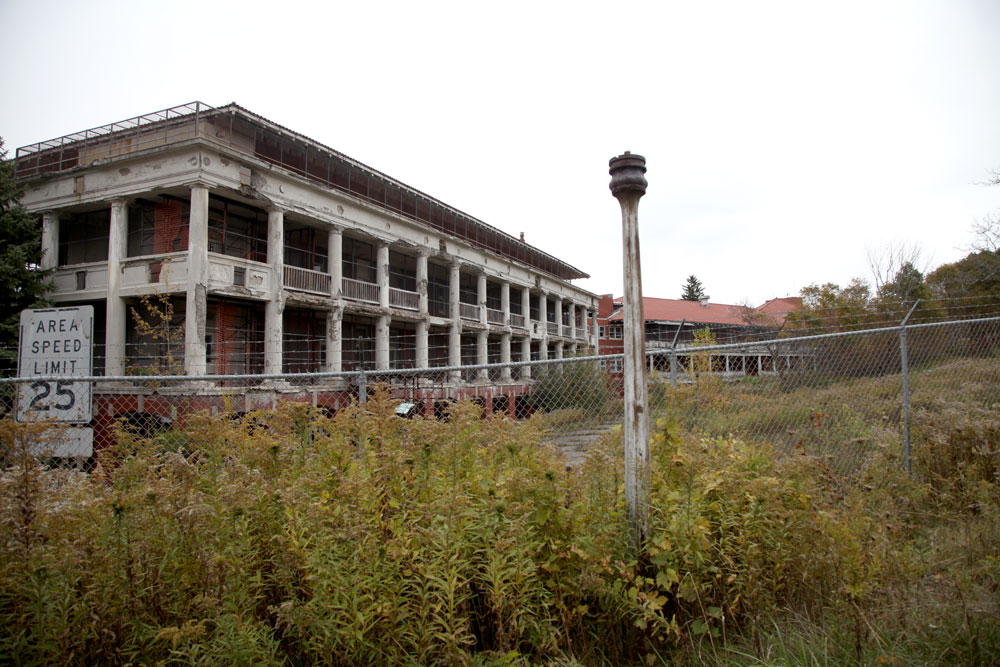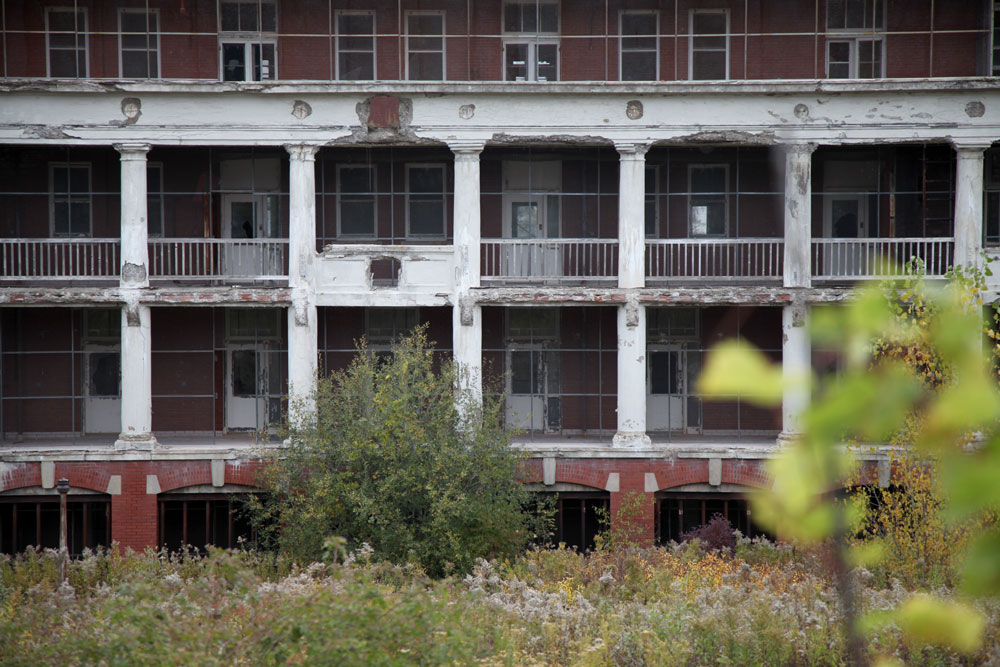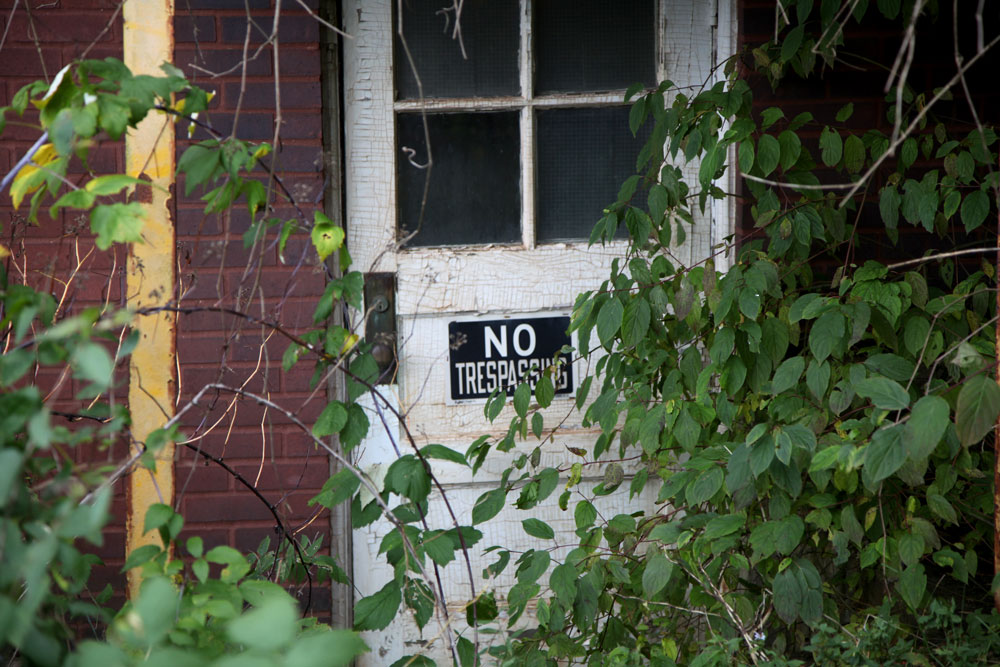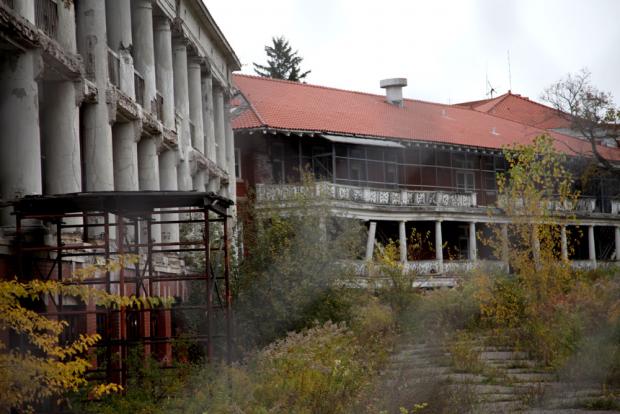Highway 62 Revisited
On my way back, I noticed that someone had plopped a World War II memorial on Transit Road near Wehrle. I cannot think of a place further from where a Word War II memorial belongs. It’s a reminder that brave men died so that we can have steaks and strip malls: “Hey, kids, let’s visit the World War II memorial on Transit Road, grab an $80 steak, then hit up Target for lettuce, a yoga mat, Cheez-Its, and a curling iron.”
But that was on my way back. On the way there, travelling down US Route 62, like my grandfather had almost 70 years before me, I was hunting for a real piece of history, not a manufactured one. I went to Perrysburg, New York to meet with town historian Jody Lee Shaw who, regarding J. N. Adam Memorial Hospital, told me that, “It was a fabulous place of community where people learned to care for each other. There are love stories, life stories, all kinds of great stories that happened there.”
I am wont to listen to my grandfather, Joseph Vizzi, Sr., tell stories, and on Christmas day last year one particular story stuck with me for months after. He mentioned that he was in a tuberculosis sanitarium for a number of years and he talked about how it changed the trajectory of his life. I was taken aback. I knew he had been sick but never really grasped the magnitude of his situation. He said, “I was at a hospital in Perrysburg, but I can’t remember the name of the place. Something Adam.”

I did what any good researcher would do: Googled it while he talked. J. N. Adam Memorial Hospital was the name of the place. The images that appeared with the search were enough to draw anyone in. You can find much written about the striking architecture and the compound’s rich history, about paranormal thrill seekers and horror stories. You can find photos taken by professionals probing for the picturesque or teenagers looking for a scare. Each photo offers a glimpse of the grounds’ former grandeur.
My grandfather was born June 7, 1931. He was raised on the East Side of Buffalo near Oak and Tupper. He often talks about the Hippodrome pool hall being his favorite haunt; there he honed skills he would later use at J. N. Adam Memorial Hospital. He loved growing up on that side of town but, in his early teen years his father opened a store at 75 Hudson Street on the West Side, Vizzi’s Market. Moving was tough, he said: All his friends were on the other side of town, and it took him a couple of buses to get over to see them. He loved it so much that he remained enrolled at Burgard High School on the East Side after they moved. At some point. in either 1946 or 1947, my grandfather wanted to start making some money. He was sick of working in the family store for nothing. So he used a family connection to get himself a job at M. Wile downtown. They let him start the job under the condition that he obtained working papers right away. For the working papers he needed a physical. As part of the physical, he was given a chest x-ray. The x-ray showed a spot on one of his lungs, which warranted a sputum test. The sputum test was positive for tuberculosis.
The country was in the midst of a tuberculosis epidemic. It is an infectious disease that travels through the air after someone infected coughs or sneezes. It can show up in bones, organs, but it mainly affects the lungs. Just as Ebola is a real concern for countries in Africa now (but not for Americans), tuberculosis was a real issue in America in the first half of the 20th century. More than 11,000 people died of Ebola in Africa between March 2014 and June 2015, while one died here. In 1900, the death rate for tuberculosis was frightening in this country: 194 died for every 100,000 people. By 1947, deaths per 100,000 had diminished to a still frightening 33. In 1947, 48,064 people died. In 1948, 43,833 people died.
My grandfather was a statistic in the 1940s; luckily for me he was not a mortality statistic. I can’t figure out exactly when he went in, or how long he was there. I do know that he was released in 1950, a fact which I will discuss later on.
He was admitted at the end of 1946, 1947, or, most likely, 1948. I visited Perrysburg’s town history museum, where they have some patient records, but not for those years.) After he found out he was positive for TB, he was told he would be sent by the county to J. N. Adam Memorial Hospital. The hospital was trying new drugs, new treatments; for instance, my grandfather was an early guinea pig for a new drug called streptomycin and artificial pneumothorax therapy. Mainly the hospital practiced the Swiss form of TB therapy. Some Swiss doctors had positive results with, as Shaw explained it to me, “Rest, fresh air, sunshine, and good food.”

On the drive to Perrysburg, you realize how secluded it is, even to this day. You can see how restful and peaceful it would be and why it was the perfect place to build a hospital that was meant to be a respite. As the road snakes toward Perrysburg the elevation rises, further compounding the separation. I came to the crest of a hilly road and, based upon my memories of road trips through New York and Pennsylvania, expected an intersection to appear with a county store or a gas station, but intersections never appeared: The horizon just kept going on and on.
If seclusion, rest, and fresh air were the requisite treatment, then Perrysburg was the perfect place to provide these things. Shaw said that sanitarium was built specifically to house Buffalo’s growing number of TB sufferers; the location was chosen not only for its remoteness but also because doctors had some luck early in the 20th century with the Swiss cure in a nearby cottage. The cottage was called Tipperary and was located in Perrysburg. A woman, Bula Lincoln, was the first treated at Tipperary and was cured.
Architect John H. Coxhead was hired to build the magnificent new facility, which opened in 1912. To really understand its scope, the best view is an aerial shot; there are a number of such photos at the museum that show all the buildings and the farms, naturally fenced by forest. There are dozens of photos of doctors, nurses, and patients—adults and children. There are photos of singers brought in to put on a live show and of children outside in beds in loincloths with multiple feet of snow on the ground. There is a guest book featuring a signature from President Franklin Delano Roosevelt. There is a set of snapshots donated by a family: The family’s patriarch and matriarch met in the hospital, the father was a patient and the mother was a nurse. The way Shaw tells it, these stories were commonplace. Often, as in the case of this family, people would stay in Perrysburg because they became accustomed to the way of life there. The hospital worked wonders for the local economy: Hotels, motels, diners, and bars all made money. Shaw brought a bodyguard on our tour, Don, in case I turned out to be some maniac looking for ghost stories. “Everyone worked at that hospital,” he told me. “My grandmother worked there.”
“Local people worked the grounds, worked on the farms,” Shaw said. “The hospital made hay for cows, milk, butter. Institutions back then didn’t have trucks coming in. They had their own canning and food production. And their own electricity.”
If you ask Shaw, the crown jewel of the museum’s collection is the beautiful model of the original hospital grounds. It almost fills an entire room in the basement of the museum. The model offers an understanding of the extent of the facility—not just how large it actually was but how self-contained and self-sustaining. It even had its own radio station and stage for concerts. On one side of the model she pointed to a tall smoke-stacked building, and behind it you can see where the coal was kept. And behind that, you can see where the railroad used to run. Coal would be dropped right there and they would pump that coal into the facilities almost directly from the train.
From Perrysburg’s Main Street, Route 39, the nondescript Airview Drive leads to the massive grounds, which are surrounded on all sides by forest, and now by barbwire fences–it’s unsafe up there due to overgrowth of plant life, rotting buildings filled with asbestos, and, allegedly, ghosts. The grounds are closed; there is a problem with thrill-seekers breaking in. On my way to meet Shaw at the Perrysburg Historical Museum, I passed the hospital to my left. I was awestruck by its grandeur. That my grandfather spent many of his formative years there was a lot to take in. Looking directly at the remarkable balconies (in the photo of him above, he is the one in the middle in his robe) I recalled our earlier conversations.
My grandfather drove into Perrysburg on a similar route, he was sure, he said, because, “even if the 90 was around, my father was old school and would never drive on a thruway.” He said that on his initial approach to the hospital, he was spellbound. He came on a weekend and was dropped off by his folks. He had no idea what to expect; all he knew about sanatoriums was what he’d heard in popular culture. The pictures at the museum depict rooms with rows of beds and dozens of patients lying down. Richard Yates, in his short story, “No Pain Whatsoever,” described a similar scene: “There were thirty-six beds in the center ward, divided half by wide aisle and subdivided by shoulder-high partitions into open cubicles of six beds each. All the sheets and the hospital pajamas were died yellow, to distinguish them from uncontaminated linen in the hospital laundry.”

I asked my grandfather if he was scared of the disease, if he was scared to be away from his family. “I was more nervous than anything, not really scared—unsure of what to think,” he said. “My first night, I was in a room with this old man and he died. Now that shocked me. I was so young I wasn’t sure what was happening. It was like I was absorbing everything.”
The old man was up all night coughing and he, like my grandfather, had TB of the lung, which is by far the most dangerous and mortal type of TB. But, being a teen, my grandfather was resilient. He wasn’t very sick, just skinny. The rest helped. He became used to the way of life and enjoyed the fact he was not at school—nor did he have to log tons of hours at the family store. He made friends and had a crew of kids around his age. “Once I was acclimated, there were times we had a ball,” he told me. “You couldn’t play baseball or anything like that, but sure as hell we could shoot pool. I got to be a pretty good pool shark. I held my own against some older black guys that were well experienced and respected me. I won a lot of cigarettes there. That’s where I learned poker, pinochle too.”
Yes, they smoked and gambled for cigarettes as they suffered from a lung disease. According to my grandfather there were levels of health; the doctors rated you based upon how sick you were; the healthier you were, the more rights you had. You could smoke, you could move around the grounds, and some were even able to leave and head to Gowanda for the day. Some guys would sneak out agasint orders to booze and meet girls. As my grandfather’s health got better, he was given more opportunity to move about the grounds, and he was given a nicer room with a balcony that he shared with another young fellow whose name he couldn’t recall. All in all, he remembers his stay fondly. And after the first night things calmed down and he didn’t see many people die.
For a few years after his release, he wrote to some of the guys he met, but gradually they fell out of contact. Now he can’t remember any names. He does remember when he was released because he was “pushing nineteen, early in 1950.” He went in a boy, a high school student—he never did return to school—and came out a young man whose life had been paused by illness. He was separated from his friends and family when he went in. When he came out, the Korean war separated him from his friends yet again. “I had to go register,” he said. “I wanted to join because all of my buddies were…well, I came out of where I was and they were all already gone, in the service.” Naturally, he was deemed, unfit to serve.
As soon as I left Perrysburg, I drove out to visit my grandfather. He was ecstatic that I’d been there. It isn’t too easy for him to travel these days, but I showed him the pictures that I took. When he saw a photo of the building with its balcony, he paused, looked off in the distance for a moment, and then he looked back at the photo. He can’t quite remember when he entered the hospital. He said it was after World War II for sure—he would remember being there during those years.
When considering Hollywood’s glamorized 1940s and 1950s, I realize that history almost missed my grandfather: He was too young for World War II, too sick for the Korean War. But history doesn’t miss anyone. You fit into a statistic someplace and, more importantly, you fit into a story.
If you have any family members who were in J. N. Adam Hospital, I highly recommend heading to see Jody Shaw—or go anyway.The Perrysburg Historical Museum is open 10am-12pm on the last Saturday of every month. There are books of documents and pictures and that amazing model to help give perspective. Who knows, maybe someone you know is in those books or photos.

